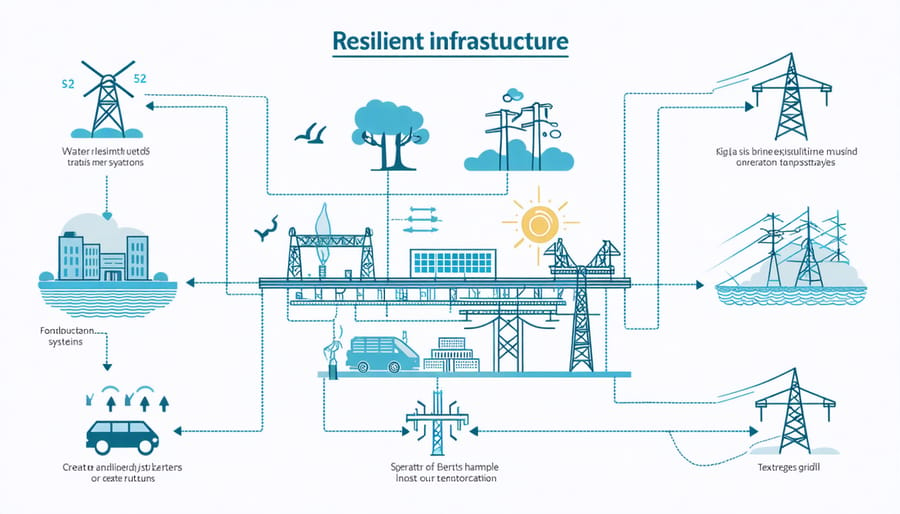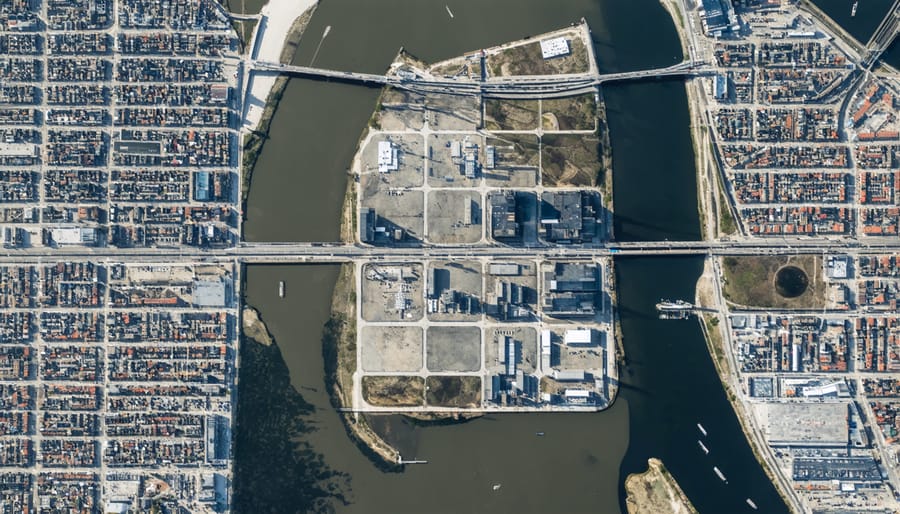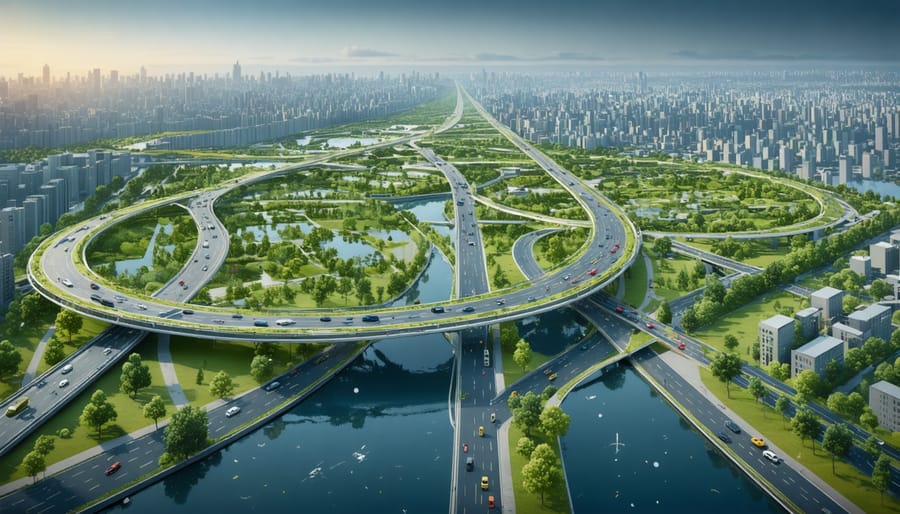In an era of unprecedented environmental challenges and urban growth, climate resilient infrastructure has become the cornerstone of sustainable urban development. Modern infrastructure must transcend traditional engineering paradigms to withstand not only current stresses but also future challenges posed by climate change, population growth, and technological advancement. This critical evolution in infrastructure design and implementation represents a fundamental shift from reactive maintenance to proactive resilience planning.
Resilient infrastructure encompasses systems and networks that anticipate, absorb, adapt to, and rapidly recover from disruptive events while maintaining essential services for communities. From transportation networks that withstand extreme weather events to power systems that self-heal during outages, these adaptive frameworks are redefining how we approach urban development and asset management. By incorporating redundancy, flexibility, and intelligent monitoring systems, resilient infrastructure ensures continuity of critical services while optimizing resource allocation and reducing long-term operational costs.
For construction professionals and urban planners, understanding and implementing resilient infrastructure principles has become non-negotiable in delivering projects that serve both present needs and future challenges.
Defining Resilient Infrastructure in Urban Contexts
Core Components of Infrastructure Resilience
Resilient infrastructure is built upon several interconnected components that work together to create robust and adaptable critical infrastructure systems. The first essential component is structural integrity, which ensures physical durability against both routine stress and extreme events. This includes using high-quality materials and implementing redundant design features that prevent single points of failure.
Adaptability forms the second core component, enabling infrastructure to modify its operation or configuration in response to changing conditions. This flexibility is crucial for maintaining functionality during disruptions and accommodating future needs.
The third component is system redundancy, which provides alternative pathways or backup systems to maintain essential services when primary systems fail. This is complemented by technological integration—the fourth component—which enables real-time monitoring, predictive maintenance, and automated responses to potential threats.
Finally, organizational readiness ensures that human systems and protocols are in place to manage and maintain infrastructure effectively, including emergency response plans and regular maintenance schedules. These components must work in harmony to create truly resilient infrastructure that can withstand, adapt to, and recover from challenges.

Adaptive Capacity and Flexibility
Adaptive capacity and flexibility are cornerstone principles of resilient infrastructure design, enabling systems to respond effectively to both anticipated and unforeseen challenges. Modern infrastructure must evolve beyond static designs to incorporate dynamic response capabilities that accommodate changing environmental conditions, usage patterns, and emerging threats.
This adaptability manifests through various design approaches, including modular components that can be easily upgraded or replaced, scalable systems that adjust to varying demand levels, and smart technologies that enable real-time monitoring and response. For instance, smart grid systems can automatically reroute power during outages, while flexible water management systems can adjust flow rates based on demand and environmental conditions.
Infrastructure flexibility also encompasses redundancy and diversity in system design. Multiple backup systems, alternative routing options, and diverse resource supplies ensure continuous operation during disruptions. The incorporation of nature-based solutions, such as bioswales and permeable surfaces, provides additional adaptability by naturally responding to environmental changes while reducing strain on traditional infrastructure.
Success in adaptive infrastructure requires forward-thinking design that anticipates future needs while maintaining current functionality. This includes implementing expandable capacity, incorporating emerging technologies, and ensuring systems can be modified without major disruptions to service.
Key Design Principles for Resilient Urban Infrastructure
Redundancy and Diversity in Design
Redundancy and diversity in resilient infrastructure design operate as complementary strategies that significantly enhance a system’s ability to withstand and recover from disruptions. By incorporating multiple layers of protection and various solution approaches, infrastructure systems maintain functionality even when individual components fail.
The principle of redundancy ensures that critical systems have backup mechanisms. For example, a resilient power grid might integrate multiple transmission pathways, distributed generation sources, and emergency backup systems. If one component fails, alternate systems maintain essential services without interruption.
Diversity in design involves implementing various solutions to address the same challenge. Consider a flood defense system that combines traditional levees with green infrastructure, permeable surfaces, and elevated structures. This multi-faceted approach ensures that if one measure proves insufficient, others continue to provide protection.
Real-world applications demonstrate the effectiveness of this dual strategy. The Port of Rotterdam, for instance, employs multiple cargo handling systems and diverse transportation routes, ensuring continuous operations even during severe disruptions. This approach has proven particularly valuable during extreme weather events and equipment failures, maintaining the port’s critical role in global supply chains.
Integration with Natural Systems
Integration with natural systems represents a fundamental shift in infrastructure design, combining engineered solutions with ecological principles to enhance resilience. This approach leverages natural processes and ecosystem services to create more sustainable and adaptive infrastructure systems. For instance, wetlands and bioswales serve as natural flood control mechanisms while providing additional benefits such as water filtration and habitat preservation.
By incorporating green infrastructure elements like urban forests, permeable pavements, and living shorelines, cities can better manage stormwater, reduce urban heat island effects, and protect against coastal erosion. These nature-based solutions often prove more cost-effective and adaptable than traditional gray infrastructure while delivering multiple co-benefits to communities.
Notable examples include Copenhagen’s cloudburst management system, which combines parks and recreational areas with flood control capabilities, and Singapore’s ABC Waters Programme, integrating natural waterways into urban infrastructure. These projects demonstrate how working with nature rather than against it can create infrastructure systems that are not only more resilient but also contribute to biodiversity, improve air quality, and enhance urban livability.
Smart Technology Integration
The integration of smart technology represents a transformative approach to building resilient infrastructure systems. Modern infrastructure networks increasingly rely on Internet of Things (IoT) sensors, artificial intelligence, and advanced data analytics to monitor structural health, predict maintenance needs, and respond to environmental challenges in real-time. These technological solutions, fundamental to smart city infrastructure, enable predictive maintenance strategies that can identify potential failures before they occur.
Digital twin technology, for instance, creates virtual replicas of physical infrastructure assets, allowing engineers to simulate various stress scenarios and optimize performance under different conditions. Advanced monitoring systems equipped with AI algorithms can detect subtle changes in structural integrity, environmental conditions, and usage patterns, facilitating proactive interventions rather than reactive repairs.
The implementation of these smart systems significantly enhances infrastructure resilience by providing real-time data for decision-making, automating response protocols during emergencies, and enabling more efficient resource allocation. This technological integration also supports adaptive management strategies, allowing infrastructure systems to evolve and respond to changing environmental conditions and user demands over time.

Real-World Applications and Case Studies
Rotterdam’s Climate Adaptation Strategy
Rotterdam, as a low-lying coastal city, has emerged as a global leader in climate-resilient infrastructure development. The city’s comprehensive adaptation strategy focuses on integrating water management solutions with urban planning to create a climate-proof metropolis by 2025.
At the heart of Rotterdam’s approach are innovative water squares, such as the Benthemplein Water Square, which serves dual purposes. During dry weather, these spaces function as community gathering areas, but during heavy rainfall, they transform into water retention basins, capable of storing thousands of cubic meters of stormwater to prevent flooding.
The city has also implemented an extensive network of green roofs and water-permeable surfaces. These features not only manage stormwater runoff but also reduce urban heat island effects and enhance biodiversity. The Dakpark, Europe’s largest green roof park, exemplifies this approach by combining flood protection with public recreational space.
Rotterdam’s harbor infrastructure incorporates adaptive measures through floating pavilions and climate-adaptive building designs. The city’s architects and engineers have developed structures that can rise and fall with water levels, ensuring operational continuity during extreme weather events.
This integrated approach has made Rotterdam a model for coastal cities worldwide, demonstrating how resilient infrastructure can effectively combine flood protection, urban development, and community engagement while maintaining economic viability. The strategy’s success lies in its holistic consideration of both immediate climate challenges and long-term sustainability goals.

Singapore’s Urban Resilience Program
Singapore stands as a global benchmark for urban resilience, implementing a comprehensive infrastructure program that addresses multiple vulnerabilities while ensuring sustainable development. The city-state’s approach combines cutting-edge engineering solutions with forward-thinking policy frameworks to create a robust urban environment capable of withstanding various challenges.
At the heart of Singapore’s resilience strategy is its water management system, featuring a network of reservoirs, drainage systems, and water reclamation facilities. The Marina Barrage, a flagship project, serves multiple functions: flood control, water supply, and recreational space, exemplifying the multi-purpose approach to resilient infrastructure.
The nation’s transport infrastructure demonstrates another layer of resilience through its integrated public transportation network, elevated MRT lines, and flood-resistant underground stations. Critical facilities, including Changi Airport and major hospitals, are built at least 4 meters above mean sea level to protect against rising sea levels and extreme weather events.
Singapore’s Building and Construction Authority (BCA) enforces strict building codes that require structures to withstand severe weather conditions and seismic activity, despite the region’s relatively low earthquake risk. These standards extend to both new developments and retrofitting existing buildings.
The success of Singapore’s urban resilience program lies in its holistic approach, combining physical infrastructure with smart technology and environmental conservation. Green buildings, urban gardens, and sustainable drainage systems work together to create a resilient urban ecosystem that serves as a model for cities worldwide.
Implementation Challenges and Solutions
Financial Considerations
The development of resilient infrastructure requires significant upfront investment, though these costs are typically offset by reduced maintenance expenses and minimized disaster recovery spending over time. Initial construction costs for resilient infrastructure projects generally run 10-20% higher than traditional infrastructure, but studies indicate a return on investment of $4-7 for every dollar spent on resilience measures.
Funding strategies often combine multiple sources, including government allocations, private sector investments, and international development funds. Public-private partnerships (PPPs) have emerged as an effective financing model, allowing risk-sharing between stakeholders while ensuring long-term project viability. Green bonds and resilience bonds are increasingly popular financing instruments, providing dedicated funding streams for climate-adaptive infrastructure projects.
Insurance companies also play a crucial role, offering specialized coverage products and often incentivizing resilient design through reduced premiums. Organizations can leverage infrastructure asset management systems to optimize their investment decisions, prioritizing critical upgrades while maintaining fiscal responsibility. The World Bank and regional development banks frequently provide technical assistance and concessional financing for resilient infrastructure projects in developing regions, helping bridge the funding gap for essential adaptations.
Technical and Engineering Challenges
Developing resilient infrastructure presents several significant technical challenges that engineers and construction professionals must address. Material selection poses a primary concern, requiring solutions that balance durability with cost-effectiveness while maintaining structural integrity under various stress conditions. Engineers must consider advanced composite materials and smart technologies that can withstand extreme weather events while providing real-time monitoring capabilities.
Another crucial challenge lies in retrofitting existing infrastructure, which often requires innovative structural reinforcement techniques without compromising operational continuity. This includes developing methods to strengthen aging bridges, tunnels, and buildings while they remain in service.
The integration of multiple systems – including power, communications, and water infrastructure – demands sophisticated engineering solutions to ensure redundancy and prevent cascading failures. Engineers must also account for the increasing complexity of cyber-physical systems and their vulnerability to both natural and human-made threats.
Climate modeling and risk assessment present additional technical hurdles, requiring advanced computational tools and predictive analytics to anticipate and mitigate potential failures. This includes developing adaptive design strategies that can accommodate changing environmental conditions and evolving infrastructure needs over time.
Policy and Regulatory Framework
The development of resilient infrastructure requires a robust policy and regulatory framework that establishes clear standards and guidelines. Government agencies and regulatory bodies play a crucial role in mandating minimum resilience requirements through building codes, zoning regulations, and infrastructure standards. These requirements typically encompass structural integrity, environmental impact assessments, and disaster preparedness measures.
Key policy instruments include financial incentives for implementing resilient design features, tax benefits for sustainable construction practices, and mandatory resilience assessments for critical infrastructure projects. Local governments often integrate these requirements into their urban resilience planning frameworks, ensuring coordinated development across different infrastructure sectors.
International standards and frameworks, such as ISO 37123 for resilient cities and communities, provide benchmarks for infrastructure resilience. These guidelines help standardize approaches across jurisdictions while allowing flexibility for local conditions. Successful implementation requires collaboration between public and private sectors, regular policy reviews, and updates to address emerging challenges and technological advancements in infrastructure development.
As we look to the future of infrastructure development, the importance of resilience cannot be overstated. Throughout this exploration of resilient infrastructure, we’ve seen how integrating robust design principles, adaptive capabilities, and sustainable practices creates systems that withstand both current challenges and future uncertainties.
The key elements we’ve discussed – from risk assessment and redundancy to innovative materials and smart technologies – form a comprehensive framework for building infrastructure that serves communities reliably while adapting to changing conditions. The success stories from cities worldwide demonstrate that resilient infrastructure is not just a theoretical concept but a practical, achievable goal with measurable benefits.
Looking ahead, the evolution of resilient infrastructure will likely be driven by emerging technologies, including artificial intelligence, advanced materials science, and improved modeling capabilities. Climate change adaptation will remain a critical factor, pushing the boundaries of what we consider resilient design.
For construction professionals and decision-makers, the path forward is clear: investing in resilient infrastructure is no longer optional but essential for long-term sustainability and economic viability. By embracing comprehensive planning approaches, leveraging new technologies, and maintaining flexibility in design and implementation, we can create infrastructure systems that not only survive challenges but thrive through them.
The future of resilient infrastructure lies in our ability to learn from past experiences, adapt to present challenges, and anticipate future needs while maintaining a balance between cost-effectiveness and robust performance.

